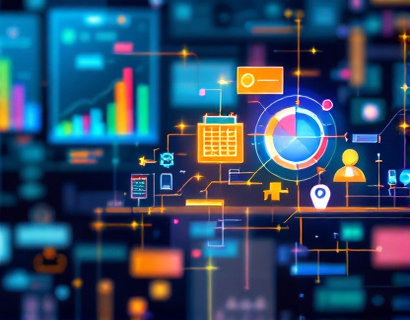AI-Powered Mental Health Navigator: Enhancing Access to Specialized Insights for a Diverse Audience
The integration of artificial intelligence in mental health services has opened new avenues for providing specialized insights and support to a wide range of users. An AI-powered chatbot designed to deliver accurate and safe information about psychiatric services and the mental health industry is revolutionizing how individuals, including children, students, educators, and healthcare professionals, engage with mental health topics. This innovative tool ensures that users receive content verified for accuracy and safety, fostering confident and responsible engagement with sensitive subjects.
Understanding the Need for Specialized Mental Health Information
Mental health is a critical aspect of overall well-being, yet it remains a topic shrouded in stigma and misunderstanding. The demand for reliable, accessible, and tailored information is higher than ever. Traditional sources of mental health information, while valuable, often fail to cater to the diverse needs of different user groups. Children, students, and mental health enthusiasts require content that is not only accurate but also age-appropriate and engaging. Similarly, healthcare professionals need up-to-date, specialized knowledge to provide the best possible care. An AI-powered chatbot addresses these needs by offering a versatile platform that adapts to the specific requirements of each user group.
AI-Powered Chatbot: A Versatile Tool for Mental Health Education
The AI-powered chatbot serves as a versatile tool, capable of providing specialized insights into various aspects of psychiatric services and the mental health industry. By leveraging advanced natural language processing and machine learning algorithms, the chatbot can understand and respond to a wide range of queries with precision and empathy. This technology ensures that users receive information that is not only accurate but also contextually relevant, enhancing the overall user experience.
Content Verification for Safety and Accuracy
One of the key features of this AI-powered chatbot is its robust content verification system. Before providing any information, the chatbot cross-references data from multiple trusted sources to ensure accuracy and safety. This is particularly crucial when dealing with mental health topics, where misinformation can have serious consequences. For children and students, the chatbot adheres to strict guidelines to ensure that the content is age-appropriate and free from harmful or inappropriate material. This verification process builds trust and confidence among users, encouraging them to engage with mental health topics more openly and responsibly.
Tailored Information for Diverse User Groups
The AI-powered chatbot is designed to cater to a diverse audience, each with unique information needs. For children and students, the chatbot provides simplified explanations and engaging content that makes learning about mental health both accessible and enjoyable. Interactive elements such as quizzes and games can help reinforce key concepts and encourage active learning. For educators, the chatbot offers resources and insights that can be integrated into curricula, helping to destigmatize mental health issues and promote a supportive learning environment.
Healthcare professionals benefit from the chatbot's in-depth knowledge base, which covers the latest research, treatment options, and industry trends. The chatbot can provide detailed information on specific psychiatric conditions, treatment protocols, and best practices, serving as a valuable reference tool. For mental health enthusiasts, the chatbot offers a broader range of topics, from general mental health tips to explorations of emerging trends and innovations in the field.
Enhancing User Engagement and Education
The chatbot's interactive nature fosters a more engaging and educational experience for all users. Through conversational interactions, users can ask questions, seek advice, and gain insights in a manner that feels natural and supportive. The chatbot's ability to understand and respond to emotional cues ensures that users feel heard and understood, which is particularly important in mental health discussions. This empathetic approach helps build a sense of trust and rapport, encouraging users to explore topics they might otherwise avoid.
For children and students, the chatbot can serve as a safe space to ask questions and learn about mental health without fear of judgment. The use of relatable language and examples makes complex concepts more digestible, promoting a better understanding of mental health issues. For educators, the chatbot can facilitate discussions and provide additional resources to support their students' mental well-being. Healthcare professionals can use the chatbot to stay updated on the latest research and clinical practices, enhancing their ability to provide comprehensive care.
Promoting Confident and Responsible Engagement
By providing accurate and safe information, the AI-powered chatbot empowers users to engage with mental health topics with confidence. Users are encouraged to seek help when needed, understand their options, and make informed decisions about their mental health. The chatbot's role in promoting responsible engagement is crucial, as it helps dispel myths and reduce stigma associated with mental health issues. This is particularly important for children and students, who may be more susceptible to peer pressure and misinformation.
The chatbot also emphasizes the importance of professional help and resources. While it can provide valuable information and support, it is clear that human expertise is irreplaceable. Users are directed to seek professional assistance when necessary, ensuring that they receive the appropriate care and support. This balanced approach helps create a more informed and responsible community, where individuals feel empowered to take care of their mental health.
Supporting Mental Health Professionals
For healthcare professionals, the AI-powered chatbot is an invaluable resource. The chatbot can provide detailed information on various psychiatric conditions, including symptoms, diagnosis, treatment options, and prognosis. This information is sourced from reputable medical databases and peer-reviewed journals, ensuring its reliability and relevance. The chatbot can also offer insights into the latest research findings, helping professionals stay at the forefront of their field.
Moreover, the chatbot can assist in case management by providing structured templates and checklists for assessments, treatment plans, and follow-up care. This can streamline the workflow for healthcare providers, allowing them to focus more on patient care and less on administrative tasks. The chatbot's ability to integrate with existing healthcare systems and electronic health records further enhances its utility, making it a seamless addition to the professional toolkit.
Ensuring Accessibility and Inclusivity
Accessibility and inclusivity are core principles in the design and implementation of the AI-powered chatbot. The platform is designed to be user-friendly, with a simple and intuitive interface that is accessible to users of all technical backgrounds. For children and students, the chatbot includes features such as text-to-speech, adjustable font sizes, and colorful visuals to make the content more engaging and accessible. This ensures that mental health education is inclusive and reaches a wide audience, regardless of their abilities or technological proficiency.
Language support is another critical aspect, with the chatbot offering multilingual capabilities to cater to a diverse user base. This is particularly important for communities where mental health resources may be limited, and language barriers can hinder access to information. By providing content in multiple languages, the chatbot helps break down these barriers and promotes mental health awareness globally.
Building a Supportive Community
The AI-powered chatbot not only provides individualized support but also fosters a sense of community among users. Through forums and discussion boards, users can connect with others who share similar experiences or interests. This community aspect is especially beneficial for children and students, who can find peer support and validation in a safe and moderated environment. Educators and healthcare professionals can also participate in these discussions, offering guidance and sharing best practices.
The chatbot moderates these communities to ensure that interactions remain positive and supportive. By setting clear guidelines and actively monitoring conversations, the chatbot helps maintain a safe space where users feel comfortable sharing their thoughts and experiences. This community-driven approach enhances the overall value of the platform, creating a network of support and knowledge sharing.
Conclusion
The AI-powered mental health navigator represents a significant advancement in providing specialized insights and support for a diverse range of users. By ensuring content accuracy and safety, this chatbot empowers individuals to engage with mental health topics confidently and responsibly. Whether for children, students, educators, or healthcare professionals, the chatbot offers tailored information and resources that promote better mental health outcomes. As technology continues to evolve, the potential for AI to enhance mental health services is vast, paving the way for a more informed and supportive society.











































